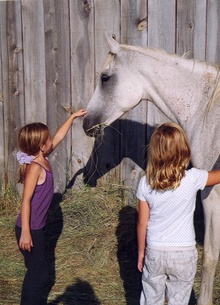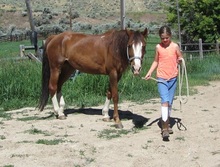Many children love horses. Some get their wish to have a horse or take riding lessons. Parents may have qualms about the safety of a child in the company of this large animal! Kids and horses make a great combination however; most horses have a lot of tolerance for children.

Danielle and Samantha approaching Veggie
A few basic safety rules are important for every child to know, partly for safety and partly to enable the child to proudly take on the responsibility of good horsemanship.
© 2015 by Heather Thomas
A few basic safety rules are important for every child to know, partly for safety and partly to enable the child to proudly take on the responsibility of good horsemanship.
Approaching and catching a horse
The first thing the child should understand is that even though a horse might be mellow and kind, it is important to never startle him. Horses are prey animals, instinctively leaping away from perceived danger, or trying to protect themselves.
If the horse is standing half asleep, don't walk quietly up behind him! Approach where he can see you, and talk to him so that he knows it's you and not a cougar sneaking up on him. If he's startled he may react by bolting or kicking.
If the child understands this basic nature of horses, this could prevent a serious accident. Most horses are accustomed to being approached and handled from their left side, so this is safest for the child to do.
After the horse has been approached, the next step is to safely put on the halter. Basic rule: loop the lead rope around the horse's neck so he knows he is caught and will stand still for putting the halter on. If the horse starts to walk off, or raises his head to avoid the halter, the child can restrain him with the loop of rope around the neck. This allows time to get the halter on, even if it's a struggle for a short child with a tall horse.
Leading a horse
When leading a horse, the safest way is to walk beside him, rather than in front of him. Explain to the child that if you walk beside his left shoulder, holding onto the halter rope or lead shank a few inches from the halter, you have the best control over his actions.

Dani and her mare
Dani walks beside her horse's left shoulder, holding onto the lead so she has the best control over her mare's actions.
© 2015 by Heather Thomas
Always have a rope or lead strap attached to the halter; don't try to lead a horse with just a halter on. If he happened to spook or jump, he would be hard to hang onto. The horse is less able to pull away from you or hurt your arm if you have a lead rope, since you can give him a bit of slack if necessary. Then he cannot jerk you as hard as if you are just trying to hang onto the halter.
Never wrap the end of the rope or lead strap around your hand. Keep the extra length in neat loops (not coils). Then it is easy to drop a loop or two, or take it back up to eliminate slack. A coil is not as safe, since it could possibly get around your hand or arm if the horse bolted.
When leading a bridled horse with loop reins, take the reins down over his head to lead him. If the reins are still up on his neck and he decides to balk, back up or bolt, you don't have control, and will make the problem worse if you hang onto him, since one side of the loop reins will be pulling on his mouth in the wrong direction.
When leading a horse that is saddled with an English saddle, run the stirrup irons up first, so they won't flop and startle him. Don't walk in front of any horse that you are leading. If he happened to spook and leap forward, he would bump into you or step on your heels. You have no control over his movements when you are in front of him.
The safest way to lead a horse is to walk beside his shoulder, moving with him. Then you have control of his head, and thus all of his actions. You can keep him at the speed you desire, and halt him when necessary.
When walking beside him, you can keep your feet from being stepped on if you move your feet with his, walking in stride. Your leg closest to the horse moves in unison with his leg that is closest to you. About the only time he can step on your foot is if yours is on the ground while his is coming down. If you are walking/jogging at the same stride as he is, your foot and his are moving together and hitting the ground together; there's less chance of him ever stepping on your foot.
Tying a horse
Make sure the horse is well trained to tie. If your child ties the horse, you don't want an accident if the horse is not truly halter-broke. Instill in the child proper techniques for tying a horse: Always use a halter and lead rope, never tie with bridle reins.

Dani demonstrating how to tie a horse
Teach your child how to tie a quick-release knot that will hold securely if the horse pulls back, but which can be untied in an emergency by pulling at the loose end of the rope.
© 2015 by Heather Thomas
Always tie to something solid (not an object that might move and startle the horse if he happened to pull a little). Never tie to a wire fence or net-wire fence, because the horse might put a foot through it if he paws.
Tie to a post or pole at least as high as the horse's withers. A horse tied too low may hurt his neck if he pulls back, or might get his foot over the rope. Allow enough slack in the rope that the horse has some freedom of head and neck (and won't feel claustrophobic from too-tight restraint) but not so much slack that he can put his head down low or try to reach for grass, or he might put a foot over the rope, or raise his head with his neck underneath it, and panic.
Teach your child how to tie a quick-release knot that will hold securely if the horse pulls back, but which can be untied in an emergency by pulling at the loose end of the rope. If a horse is tied, take care not to startle him or he may pull back and hurt himself or a person.
Grooming and handling feet
Teach your child the proper way to work around a horse, and how to pick up feet for cleaning, and to observe basic safety rules.
When tending to a horse's lower leg or hoof, never kneel or sit on the ground. Remain squatting, so you can jump away in the event he startles.
Proper position and body contact are important. You are much less apt to get bumped, kicked or stepped on if you are close to the horse and touching him, able to move when he moves. You are more able to keep him from moving inappropriately, and if he does move, you can move with him (and move your feet) instead of being bumped into or having your feet stepped on.
If you or the child bends over to examine or do something with a front foot, never be right in front of that leg. The horse may unintentionally bump you just by picking up the foot, and his knee could hit you in the face.
When working around the hindquarters, be aware that maintaining close contact is always safer than being a short distance away where you could get the full force of a kick or be knocked down if the horse startles in your direction. If you are touching the hindquarters you can move with the horse, and not be hurt. Safety first is the best policy.
First in the series
This is the first in a series of articles on Kids, Horses and Safety written by Heather Smith Thomas, author of Horse Tales, Training Horses, The Horse Conformation Handbook and many other books and articles. Look for the second article coming in July.
